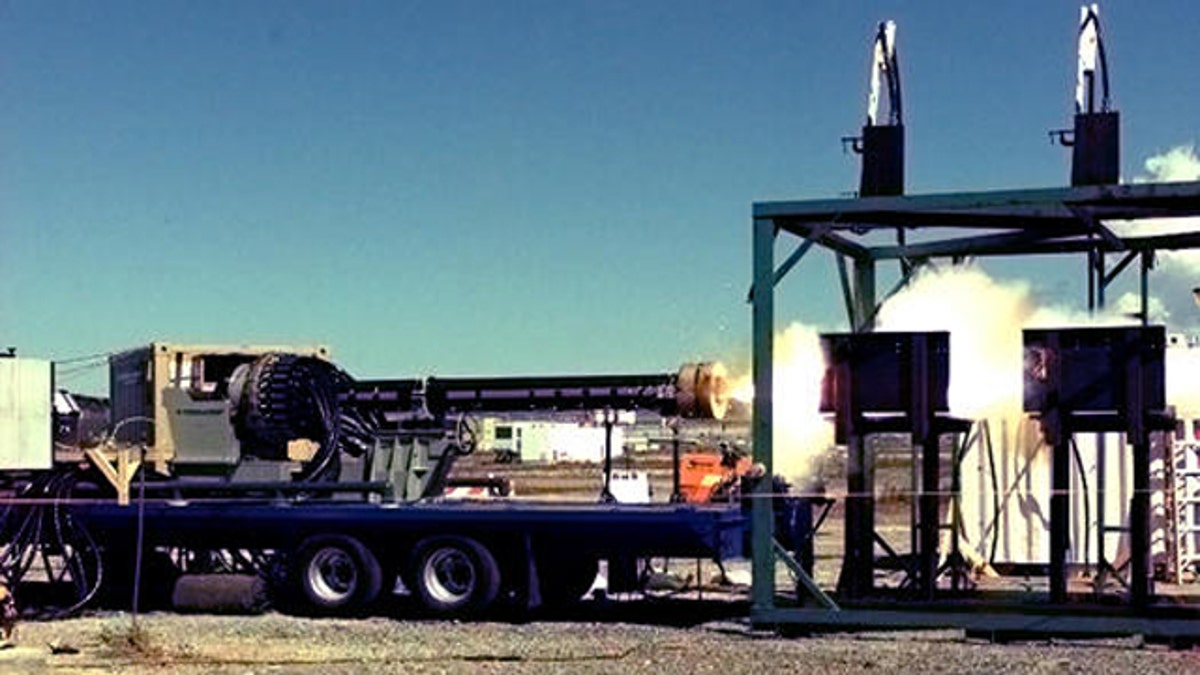
General Atomics tests the Blitzer railgun, a prototype weapon that fires slugs propelled by electromagnets rather than explosions. (General Atomics)
The Navy's most futuristic weapons will remain more fi than sci.
The Senate Armed Services Committee on Friday voted to eliminate funding for two of the Navy’s still-in-development guns: the free electron laser, essentially a super-powered death ray, and the railgun, which shoots bullets powered not by explosions, but by energy.
The Navy had planned to incorporate these sci-fi weapons in a revamped fleet of the future, and asked for $60 million to continue research and development. Those plans may have to change, following the tersely worded cuts -- unveiled on Page 21 of a lengthy press release outlining the Senate's completion of the National Defense Authorization Act of 2012.
"'[The Act] directs the Navy to develop a broader affordable strategy on laser systems and terminates the Navy’s free electron laser due to concerns over operational technical challenges. In addition, [it] terminates the Navy’s high-risk Electromagnetic Rail Gun," the release reads.
Neither the Navy's Office of Naval Research, which has been actively developing the two technologies for several years, nor senior Navy officials were willing to comment on the news, pending the release of the full bill later this week.
The cuts come on the heels of major successes by both weapons: In February the free-electron laser set a new power record, bringing it closer to the goal of megawatt-class power. In December, the railgun produced a walloping 33-megajoule blast, three times the power previously achieved.
Rick DeBobes, the chief of staff for the committee, told reporters at a press conference that his group felt the two programs were too high risk to justify further development.
“The determination was that the free electron laser has the highest technical risk in terms of ultimately being able to field in a ship. And so we thought the Navy could better concentrate on other laser programs,” DeBobes said.
The Navy disagrees, having recently awarded Boeing a contract worth up to $163 million to take the tech and package it as weapons system, one that the Navy hopes to use not only to destroy things but for on-ship communications, tracking and detection, too -- using a fraction of the energy such applications use now, plus with more accuracy.
Elizabeth Merida, a Boeing spokeswoman, said it was too early to determine whether that contract would be canceled.
"The FY 2012 defense budget is a work in progress, so it is still too early to conclude what it ultimately will mean for Boeing and our customers," she told FoxNews.com. "We will continue to work with the Navy to evaluate the draft defense budget and its potential impact.”
The railgun faces different technical challenges, the Senate release said, notably the years of development still ahead before it becomes a feasible weapon.
“With the electromagnetic railgun, the committee felt the technical challenges for developing and fielding the weapon would be daunting. And particularly with the power that would be required and the barrel of the gun having very limited life,” DeBobes said.
"Once again, we felt that the Navy could better spend the money on other science and technology challenges."
General Atomics, the defense contractor behind the Predator drone, worked with the Navy on the railgun; the company's Blitzer system shot the Navy's Mach 5 round in December. But the project wouldn't have been completed until 2035 at the earliest, officials had said.
The bill now moves to the Senate floor, where it will be taken up this summer.
Despite these cuts, the overall budget looks good for research: It authorizes a net increase of $83 million above the budget request level of $12.25 billion for science and technology activities.




















